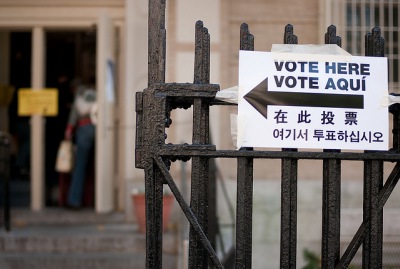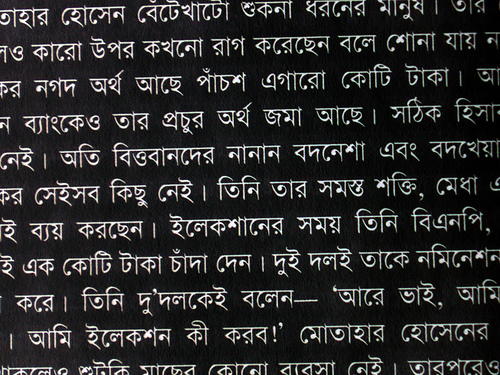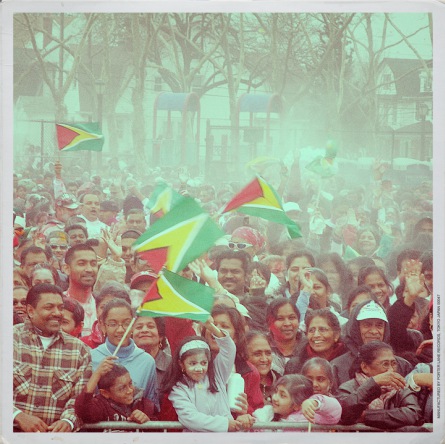Ballots or Bedlam

NEW YORK — Much will be at stake when New Yorkers go to the polls tomorrow, but perhaps nothing more so than the basic right to vote.
As of yesterday, less than 72 hours before Election Day, tens of thousands of voters were confusingly assigned new poll sites after Hurricane Sandy knocked out power to or damaged the usual spots where they cast their ballots.
Some of those 60 or so unusable sites have also been consolidated into about 26, meaning crowds of voters will likely show up at overtaxed schools or private sites to pick their candidates, which could lead to long waits at the polls.
Some voters will also be making their picks outside in tents, while others may need to be bused from devastated neighborhoods and shelters to make their voices heard.
And for many people who turn out to vote in this critical election — if they are not dealing with flooded or destroyed homes, displacement or other, more important problems caused by the aftermath of the storm — it will be the first time they will use the new electronic voting machines.
If all that wasn't bad enough, the city Board of Elections, which has been known to bungle the administration of the democratic process on more than one occasion during relatively normal circumstances, has been without power at its lower Manhattan headquarters since last week after it was flooded (a satellite office in Staten Island has also been closed for the same reason).
Along with the electricity went the Boards's voter hotline, though people can call 311 to find out their poll sites.
The Board says its staff has been working round-the-clock to relocate polls, process absentee ballots and get the word out about the election. And, from what could be gleaned from interviews with officials and good government groups over the past few days, there was a semblance of coordination among the board, mayor's office, governor's office and federal and state officials to address the problem with voting sites.
But yesterday, after publishing what it said was the final poll list for the election, the Board updated it hours later. "There are some sites now that are viable at this minute that were not," said Board Commissioner Juan Carlos "J.C." Polanco yesterday afternoon. "In an effort to use the poll sites that were already there, we are using the ones that are there and have power and are viable."
Mayor Michael Bloomberg, speaking at a news conference yesterday, didn't give the Board his vote of confidence.
“Over the next day, it’s going to be critical that the Board of Elections communicate this new information to their poll workers," he said. "Unfortunately, as you know, the Board has had a history of not opening all poll sites on time, and they’re going to work hard to make sure that poll workers and voters know where they’re supposed to go on Election Day."
He said NYC Service volunteers are helping to notify the estimated 143,000 voters in all five boroughs who were assigned new poll sites.
Valerie Vazquez, a spokeswoman for the Board, said staff was planning to distribute information at shelters about where people can vote, posting signage at old poll sites directing voters to new ones and doing full page ads in citywide and local newspapers about the poll site changes.
New Yorkers can also text "NYCVOTES" (or "DONDE") to 877-877 to receive a message on their phones with their poll site. The technology is being donated to the city by Mobile Commons.
"As New Yorkers, we came together to hold a calm, orderly election following 9/11. We will do it again in the aftermath of Sandy," said Onida Coward Mayers, director of NYC Votes!, the nonpartisan voter engagement campaign of the NYC Campaign Finance Board, in a statement. The campaign announced the text messaging software. "There will certainly be some challenges on Tuesday and it will require some patience, but it is important that all New Yorkers head to the polls to make our voices heard."
Even with these efforts, good government groups are worried that Election Day will be a mess.
Alex Camarda, the director of public policy and advocacy at Citizens Union, the sister organization of Gotham Gazette, said the Board was facing a vastly complicated election.
"I think it's going to be a Herculean task, and that the Board is going to have to bring better than their A game to pull this off without a problem," he said, adding that long lines and voter confusion were likely. "It's incumbent on the city and state to use their resources as well to get the word out so that we don't see fewer people voting as a result."
Turnout is a particular problem in New York City. According to a report by the Campaign Finance Board released in June, only 18 percent of voting age New Yorkers turned out to vote in the 2009 general election for mayor.
Any drop in turnout could have an effect on pivotal races for the U.S. Congress and the state Senate where candidates have suspended their campaigns in recent days to respond to the devastation in their communities on Staten Island, Queens and Brooklyn.
Ashton J. Stewart, the executive director of the League of Women Voters of New York City, said people were confused before the storm about where to vote because redistricting had relocated their poll sites.
"We were already up to our necks addressing the normal concerns with the general election," he said, worrying that turnout could be further suppressed because of the problems caused by the storm. "The people that do live in homes and are currently without power, I just don't know, I hope they still go to the polls."
City Fails Bengali Ballot Test; Elections Board Says It Has Plan” Maybe

NEW YORK — Asian Americans continue to face "many barriers in exercising their right to vote" in several jurisdictions throughout the county, including in Queens, a civil rights group says.
In a report on local compliance with federal laws for language assistance at the polls, the Asian American Legal Defense and Education Fund said yesterday that New York City was the only one of four jurisdictions in the U.S. that failed in its obligation to translate ballots into Bengali.
The other three jurisdictions were Cook County, Ill.; Hamtramck, Mich.; and Los Angeles, Calif.
The report also underscored that four elections have passed since the city was required by federal law in 2011 to provide language assistance in a South Asian language to voters in Queens.
The city's Board of Elections has said it will not be able to translate ballots into Bengali in time for the general election, but a revised draft plan to help Bengali speaking voters on Nov. 6 was made public at a a meeting of the agency's commissioners yesterday. The plan does not include Bengali ballots.
A spokeswoman for the board responded to a request for comment about the AALDEF report by forwarding the draft plan.
An attorney with AALDEF, Glenn D. Magpantay, said the plan addressed some concerns. "It's a good plan, but there's still room for mischief," he said.
He said he commended the board for making an effort, but said the issue of Bengali ballots had been raised for months.
"We've been yelling at them since December of last year to get this done," he said. "They haven't done nothing. They've recruited interpreters, but no one knows how to access them."
Most recently, the board blamed the failure to translate the ballot into Bengali in time for November's election on the voting machine vendor, Elections Systems & Software.
But AALDEF said in its report that the same company was able to provide Bengali-language ballots for voting machines in time for Michigan's primary election in February.
AALDEF's Magpantay concedes that the software used in Michigan is slightly different, but he said of the board: "They have the technology."
ESS's representatives didn't respond to a request for comment.
AALDEF's report, based on monitoring of 56 poll sites in five jurisdictions around the country during this year's primaries, also found that voters in Queens often didn't know that language assistance was available and that "several" poll sites didn't have the required number of official interpreters.
The report also documented how one poll worker made disparaging remarks about Bengali and an instance where an "interpreter available" sign was written in Chinese even though Bengali and Hindi translators were sitting in front of it.
Under federal law, the city was supposed to have arranged to have voter registration forms, ballots, materials and interpreters available for Bengali readers in Queens during this year's elections.
While most, if not all, of the other materials have been translated, the ballot has not.
The board's draft plan calls for making a list of candidates' names available in Bengali at poll sites, translating sample ballots and other materials, as well as the hiring of interpreters.
Magpantay said his organization is weighing its options for forcing the board into compliance with federal law, including and up to filing a lawsuit over the delay in rolling out Bengali ballots.
"This is a very important election," he said. "The emerging South Asian community in Queens has a right to vote in their language."
Seeking Unity for a Queens Neighborhood

NEW YORK — Where I grew up in southwest Queens, roti shops are the local cafes, Hindu religious stores sell saris and the smell of simmering chicken curry is easily chanced upon as you walk the streets.
Whether in South Ozone Park, Ozone Park or Richmond Hill, the influence of Indian cultures from Guyana, Trinidad and Suriname creates unity among the three adjacent neighborhoods.
But others apparently don’t see our community as one that shares common interests and that deserves a chance at supporting its own candidate for City Council.
Every ten years following the decennial census, the city goes through the process of redrawing the district lines for City Council members, in part by looking at demographic changes in the five boroughs.
Under the current proposal from the city’s Districting Commission, my neighborhood would be split by Lefferts Boulevard, leaving District 28 and District 32, including Ozone Park and South Ozone Park, as two distinct areas. Richmond Hill, in turn, would lie in the center of both districts, with Lefferts Boulevard cutting through them.
What is at stake is the community’s power to pick elected officials who will respond to their concerns, advocates say.
“It dilutes the power of residents in the area,” said Richard S. David, executive director of a southern Queens-based nonprofit, the Indo-Caribbean Alliance, in a recent interview.
David said the current district lines proposal “fails” the community by making it more difficult to push for legislation and policy issues if there are multiple elected officials representing a minority split between various districts.
“We are not proposing to have a majority of Indo-Caribbean and South Asians — we just want to keep the community together. We are not going to be the largest but we are going to be bigger than we are now,” he said.
The 2010 census shows that 62 percent of the city’s South Asians live in Queens, while nearly 30,000 residents identified themselves as “Asian Indian” in South Richmond Hill, Ozone Park, and South Ozone Park.
Advocates from community organizations, such as Taking Our Seat, a group dedicated to addressing the causes of voter-dilution among South Asians, say that four census tracts with high South Asian voting populations in Richmond Hill and South Ozone Park are split between four different City Council districts using major roadways such as Lefferts Boulevard and 101st Avenue as dividing lines where the community occupies both sides.
Instead of the South Asian and Indo-Caribbean population in Richmond Hill, Ozone Park, and South Ozone Park voting as one block of constituents, their votes end up as a small margin in four different City Council districts currently represented by Ruben Wills, Erich Ulrich, Elizabeth Crowley and Karen Koslowitz, according to advocates.
Queens residents from the neighborhoods testified in front of the city Districting Commission on Oct. 10, calling for the communities to be drawn into one district, not separated into three different ones.
Shirley Limongi, the spokeswoman for the districting commission, said in a recent interview that hearing testimonies from local residents helps to identify potential “communities of interest.” She noted that some factors that define a community of interest are shared religion, race, language and ethnicity.
At the hearing, a group of South Asian and Indo-Caribbean local residents from southern Queens wearing “Keep Richmond Hill United” t-shirts and holding up posters of a map uniting the two districts testified. Some were angry at the commission, some delivered their stories as immigrants and some called for redrawing the map completely.
Even business leaders were concerned about the proposed Council lines. “We have made a significant presentation, including testimonies, maps, t-shirts, placards — what else do we need to do? Please work with us,” said Vishnu Mahadeo, the president of the Richmond Hill Economic Development Council, to the 15 commissioners, at the hearing.
The splitting of the community affects how easy it is for a person of South Asian descent to run as an elected official, advocates say.
“The reality is in New York people vote along racial lines — if the lines are not drawn where you have the racial advantage, then you have to break that norm where it can be possible,” David said, giving examples of elected officials such as Councilwoman Margaret Chin, who represents Chinatown, and Councilman Peter Koo, who represents Flushing — both major Chinese American enclaves.
Advocates at the hearing also cited the Unity Maps proposed by civil rights groups, showing that the three neighborhoods could be kept as one district if Van Wyck Boulevard was made the dividing line instead of Lefferts Boulevard.
My parents, like so many others, left their native country Guyana but they soon found a neighborhood that became a second home to them — with Trinidadians, Surinamese, Sikhs, and Punjabis all holding a common Indian ancestry.
As a second-generation child of Guyanese immigrants, I see my surrounding community as a cohesive whole. I am a youth leader in my Hindu temple in Ozone Park, I write in a local newspaper called The West Indian, circulated throughout Richmond Hill’s roti shops, and I grew up in my South Ozone Park home, where I still live in today.
For me, the main concern of the independent commission should be to protect and empower ethnic populations within marginalized communities. But if the commission does not unite our South Asian community in one district, it may send a message that this community is not of interest.




